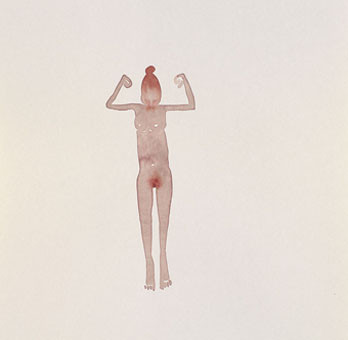David Austen
16 Sep - 22 Oct 2011
DAVID AUSTEN
Papillon
16 September - 22 October 2011
Perseus holds the Gorgon’s head; Apollo pokes his bloodied sword at the flayed body of Marsyas; Adam and Eve are banished from Eden; Christ lies beaten, crucified, dead before resurrection. But these grim events are imagined in the exquisite delicacy of watercolour.
Men, women, monsters and Christ. Austen dips his brush into the pellucid colour and from the skin of water is born the skin of flesh. A gesture so light, so ethereal, so economical and yet the source of tragedy, mystery, cruelty and death. Transformation. Austen is a master of his medium; he is one of the finest draughtsmen working today.
The human figure, in its vulnerability, comedy, grandeur, pathos, innocence, beauty has no more lucid or economical interpreter. These few works on paper, so materially delicate, stroking the surface, resonate with an extraordinary intensity of emotion. Their nakedness is total, their comedy is pathetic but their mythological grounding and technical brilliance give them a profound inevitability.
Three of Austen’s paintings are also included in the exhibition. Once again, despite the grand statement of their figuration they are born out of a refined miniaturism and delicacy of touch; the small brush marks and charcoal abrasions building up to an absorbing surface intensity. Transformation again: text to image; black to white; drawing to painting. Hoods and Goons strutting expansive across the canvas.
No mere lepidopteran this Papillon but a spreading of our own wings, bursting from the dark. A loss of Eden and the embrace of knowledge. No ordinary Tree this charcoal labyrinth but a pubic thicket of branches, a fantastic growth, a painter’s foreplay left as the drawing that anticipates the paint.
In recent years, Austen has expanded his work into film with considerable critical acclaim. In a series of short silent blackandwhite pieces he has explored power of the medium to transform the simple image but it is Austen’s eye for that image that is remarkable. Two longer scripted films, Crackers and End of Love have been screened widely both in this country and abroad. Austen’s most recent museum exhibition was at Modern Art Oxford early this year. He was also featured in the acclaimed exhibition Watercolour at Tate and his work is in many important public collections in the UK, Europe and the USA.
Papillon
16 September - 22 October 2011
Perseus holds the Gorgon’s head; Apollo pokes his bloodied sword at the flayed body of Marsyas; Adam and Eve are banished from Eden; Christ lies beaten, crucified, dead before resurrection. But these grim events are imagined in the exquisite delicacy of watercolour.
Men, women, monsters and Christ. Austen dips his brush into the pellucid colour and from the skin of water is born the skin of flesh. A gesture so light, so ethereal, so economical and yet the source of tragedy, mystery, cruelty and death. Transformation. Austen is a master of his medium; he is one of the finest draughtsmen working today.
The human figure, in its vulnerability, comedy, grandeur, pathos, innocence, beauty has no more lucid or economical interpreter. These few works on paper, so materially delicate, stroking the surface, resonate with an extraordinary intensity of emotion. Their nakedness is total, their comedy is pathetic but their mythological grounding and technical brilliance give them a profound inevitability.
Three of Austen’s paintings are also included in the exhibition. Once again, despite the grand statement of their figuration they are born out of a refined miniaturism and delicacy of touch; the small brush marks and charcoal abrasions building up to an absorbing surface intensity. Transformation again: text to image; black to white; drawing to painting. Hoods and Goons strutting expansive across the canvas.
No mere lepidopteran this Papillon but a spreading of our own wings, bursting from the dark. A loss of Eden and the embrace of knowledge. No ordinary Tree this charcoal labyrinth but a pubic thicket of branches, a fantastic growth, a painter’s foreplay left as the drawing that anticipates the paint.
In recent years, Austen has expanded his work into film with considerable critical acclaim. In a series of short silent blackandwhite pieces he has explored power of the medium to transform the simple image but it is Austen’s eye for that image that is remarkable. Two longer scripted films, Crackers and End of Love have been screened widely both in this country and abroad. Austen’s most recent museum exhibition was at Modern Art Oxford early this year. He was also featured in the acclaimed exhibition Watercolour at Tate and his work is in many important public collections in the UK, Europe and the USA.

